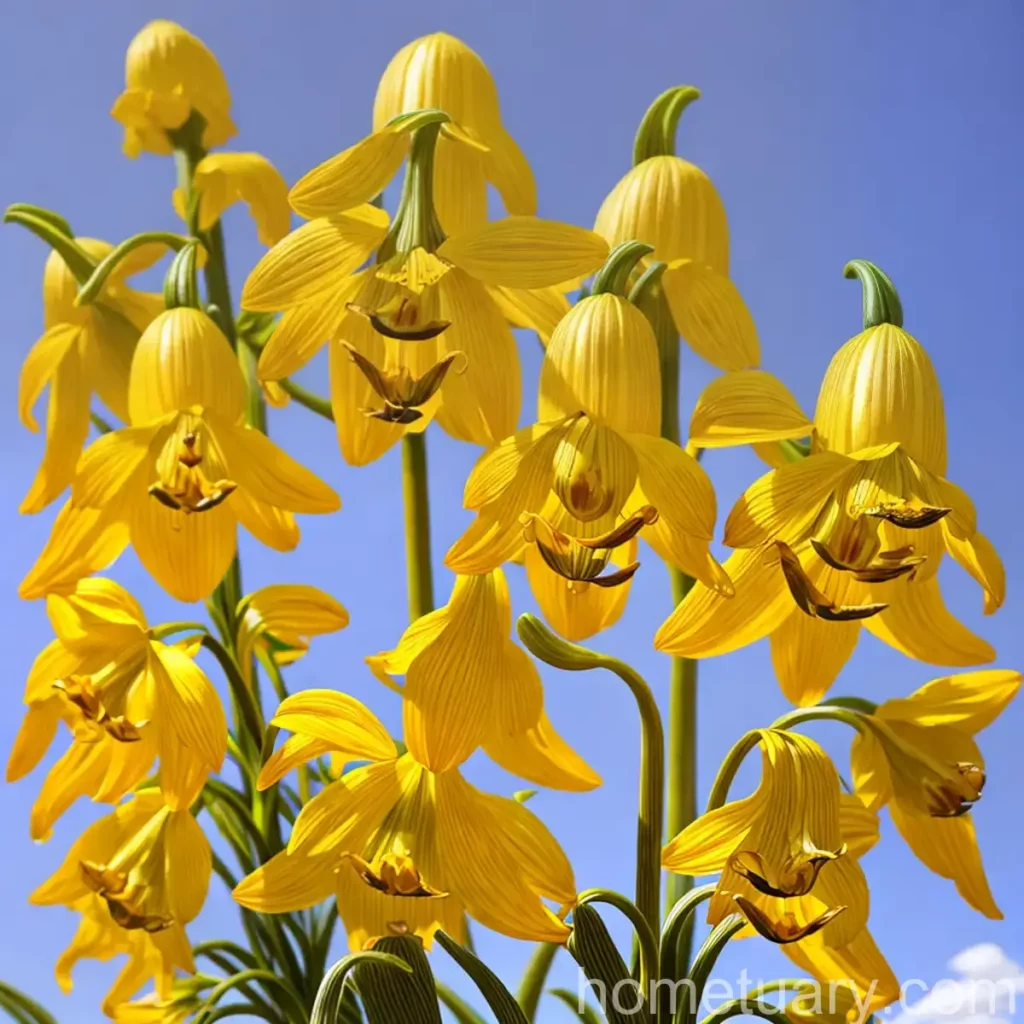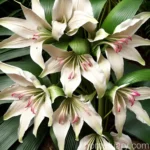Crown Imperial (Fritillaria Imperialis ‘Lutea’)
In the world of ornamental plants, the crown imperial, scientifically known as Fritillaria imperialis ‘Lutea,’ holds a special place. This striking plant is renowned for its tall stems adorned with bright yellow, bell-shaped flowers and impressive foliage. It brings a regal presence to gardens, making it a popular choice for many gardeners and landscapers.
What is Crown Imperial?
The crown imperial, Fritillaria imperialis ‘Lutea,’ is a member of the Liliaceae family, which includes more than 100 species under the genus Fritillaria. Native to the mountainous regions of Turkey, Iran, and central Asia, it thrives in well-drained and fertile soil, providing a delightful display of flowers in the early spring.
Key Takeaways – Crown Imperial (Fritillaria Imperialis ‘Lutea’)
Before delving into the specific details of caring for the crown imperial, let’s take a look at the key aspects of this remarkable plant:
- Scientific Name: Fritillaria imperialis ‘Lutea’
- Family: Liliaceae
- Common Name: Crown Imperial
- Color: Yellow
- Height: 3-4 feet
- Flowering Season: Spring
- Hardiness Zone: 5-9
- Sunlight: Full sun to partial shade
- Soil: Well-draining, fertile
- Water: Moderate
- Uses: Ornamental, cut flower
- Special Feature: Fragrant flowers
- Pest & Diseases: Susceptible to aphids, crown rot, and mites
Now, let’s explore the finer details of how to care for and grow the crown imperial in your garden.
Culture
The culture of the crown imperial is centered around creating optimal conditions for its growth and flower production. This encompasses various factors including water, sunlight, fertilizer, soil, and pruning.
Uses
The crown imperial is primarily used for ornamental purposes in gardens and landscapes. Its impressive height and striking flowers make it a focal point in any setting. Additionally, the cut flowers are popular for floral arrangements, adding a touch of elegance and exoticism.
Water
When it comes to watering the crown imperial, it is crucial to strike a balance. Overwatering can lead to root rot and other issues, while underwatering can hinder flower production and overall growth. It is essential to keep the soil evenly moist, but not waterlogged, especially during the growing and flowering periods.
Sunlight
The crown imperial thrives in full sun to partial shade. In regions with hot summers, providing some shade during the hottest part of the day can prevent the plant from becoming stressed. However, in cooler climates, full sun is generally well-tolerated.
Fertilizer
Fertilizing crown imperial bulbs is important for ensuring healthy growth and vibrant flowers. A balanced, all-purpose fertilizer can be applied in the early spring as the plant emerges from the soil. Additionally, a light application of fertilizer during the flowering period can support the plant’s nutritional needs.
Soil
Well-draining and fertile soil is essential for the crown imperial to thrive. It does best in moderately rich soil with a slightly acidic to neutral pH. Amending the soil with organic matter such as compost can improve its texture and fertility, providing an ideal growing medium for the plant.
Pruning
Pruning the crown imperial primarily involves removing spent flowers and any discolored or diseased foliage. This helps redirect the plant’s energy into new growth and ensures a tidy appearance. Additionally, pruning is essential after the flowers have faded to prevent the formation of seeds, which can divert energy away from the bulb.
Propagation
Propagating the crown imperial can be done through offsets, seeds, or bulb division. Offsets are small bulbs that develop around the main bulb and can be carefully removed and replanted. Seeds can be collected from the pods once they have matured, and bulb division can be carried out during the plant’s dormant period.
Container Popularity
While the crown imperial is often grown in garden beds, it can also thrive in containers given the right conditions. This makes it a popular choice for gardeners with limited space or those who want to create stunning focal points on patios and balconies.
Container
When choosing a container for growing crown imperial, it is important to select one with adequate drainage holes to prevent waterlogging. The container should also be sufficiently large to accommodate the bulb and provide room for the roots to grow.
Common Diseases
Like any plant, the crown imperial is susceptible to certain diseases and pests. Understanding and identifying these issues is crucial for effective management and ensuring the plant’s health and vitality.
Disease Diagnosis
Some common diseases that can affect the crown imperial include crown rot, botrytis, and rust. Crown rot is often caused by overly wet conditions and can lead to the decay of the bulb and roots. Botrytis, or gray mold, can develop in humid conditions and affect the foliage and flowers. Rust appears as orange-brown spots on the leaves and stems.
Common Pests
Pests such as aphids and mites can also pose a threat to the crown imperial. Aphids are small, sap-sucking insects that can cause stunted growth and distorted leaves. Mites, on the other hand, are microscopic pests that can produce fine webbing and cause discoloration and damage to the plant.
Botanist’s Tips
To ensure the successful cultivation and care of the crown imperial, consider the following tips:
- Plant bulbs at the appropriate depth – typically 6-8 inches deep
- Provide good air circulation to prevent fungal diseases
- Monitor for signs of pests and diseases regularly
- Avoid overhead watering to reduce the risk of fungal issues
- Mulch around the base of the plant to retain soil moisture and suppress weeds
Fun Facts
- The crown imperial has been cultivated since the 16th century and is a well-established ornamental plant in many parts of the world
- The pungent odor emitted by the crown imperial bulbs deters rodents and pests, making them a natural deterrent in the garden
- In its native regions, the crown imperial has historical medicinal uses, although it is not commonly utilized for such purposes today
Links to External Resources
For further information on the crown imperial and its cultivation, the following resources are valuable references:
- Royal Horticultural Society – Crown Imperial
- Missouri Botanical Garden – Fritillaria imperialis ‘Lutea’
- Gardening Know How – Crown Imperial flowers
In conclusion, the crown imperial, Fritillaria imperialis ‘Lutea,’ is a captivating and elegant addition to any garden. With proper care and attention to its cultural requirements, it can thrive and enchant with its majestic presence and vibrant blooms. Whether in the ground or in containers, this regal plant is sure to make a lasting impression, beckoning admiration and awe from all who encounter it.
Keywords: Crown imperial flower, Fritillaria imperialis ‘Lutea’, Fritillaria plant, Lutea crown imperial, Crown imperial bulbs, Fritillaria lutea flower, Fritillaria family, Crown imperial care, Fritillaria imperialis ‘Lutea’ varieties, Fritillaria lily, Fritillaria imperialis cultivation, Crown imperial plant, Fritillaria imperialis ‘Lutea’ characteristics, Lutea fritillary, Fritillaria imperialis garden, Crown imperial growing tips, Fritillaria imperialis ‘Lutea’ care guide, Yellow crown imperial, Fritillaria imperialis diseases, Fritillaria imperialis ‘Lutea’ maintenance, Crown imperial planting guide, Fritillaria imperialis ‘Lutea’ bulbs, Fritillaria imperialis ‘Lutea’ habitat, Crown imperial flower facts, Fritillaria imperialis ‘Lutea’ propagation, Fritillaria imperialis ‘Lutea’ uses, Crown imperial in gardens, Fritillaria imperialis ‘Lutea’ growth cycle, Fritillaria imperialis ‘Lutea’ pest control, Crown imperial plant care, Fritillaria imperialis ‘Lutea’ landscape use, Fritillaria imperialis ‘Lutea’ characteristics, Crown imperial bulb planting, Fritillaria imperialis ‘Lutea’ blooms, Fritillaria imperialis ‘Lutea’ soil requirements, Growing Fritillaria imperialis ‘Lutea’ from seed, Crown imperial flower arrangement, Fritillaria imperialis ‘Lutea’ in containers, Fritillaria imperialis ‘Lutea’ pruning tips, Crown imperial watering needs, Fritillaria imperialis ‘Lutea’ companion plants, Fritillaria imperialis ‘Lutea’ medicinal uses, Crown imperial flower garden ideas, Fritillaria imperialis ‘Lutea’ indoor cultivation, Fritillaria imperialis ‘Lutea’ winter care, Crown imperial flower symbolism, Fritillaria imperialis ‘Lutea’ naturalize, Fritillaria imperialis ‘Lutea’ fragrance, Crown imperial fall planting, Fritillaria imperialis ‘Lutea’ foliage color















